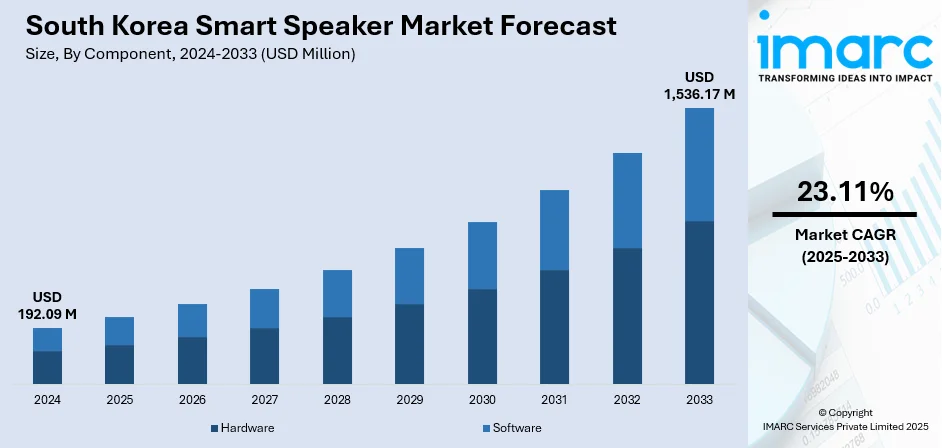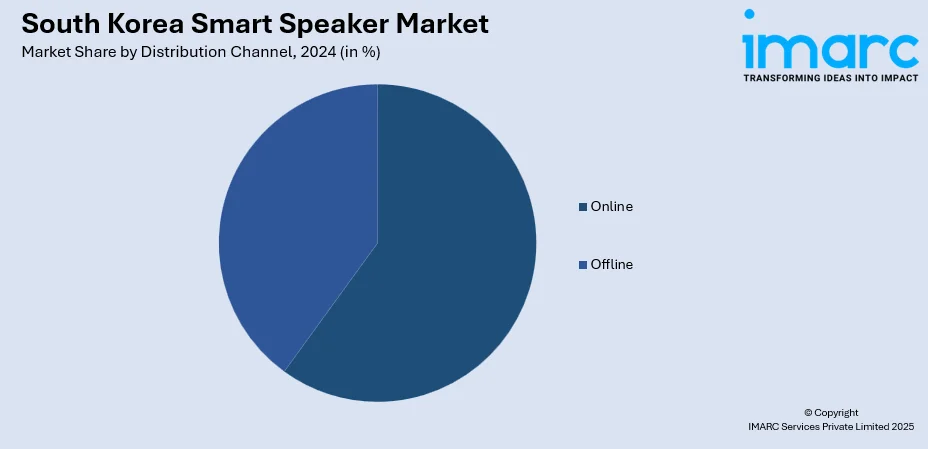
South Korea Smart Speaker Market Size, Share, Trends and Forecast by Component, Intelligent Virtual Assistant, Connectivity, Price Range, Distribution Channel, End User, and Region, 2025-2033
South Korea Smart Speaker Market Overview:
The South Korea smart speaker market size reached USD 192.09 Million in 2024. Looking forward, IMARC Group expects the market to reach USD 1,536.17 Million by 2033, exhibiting a growth rate (CAGR) of 23.11% during 2025-2033. South Korea’s aging population is driving the demand for accessible, health-focused smart speakers, while e-commerce accelerates their adoption through fast delivery, targeted promotions, and bundled services. These combined trends are transforming smart speakers into essential tools for daily life and wellbeing, contributing to the expansion of the South Korea smart speaker market share.
|
Report Attribute
|
Key Statistics
|
|---|---|
|
Base Year
|
2024 |
|
Forecast Years
|
2025-2033
|
|
Historical Years
|
2019-2024
|
| Market Size in 2024 | USD 192.09 Million |
| Market Forecast in 2033 | USD 1,536.17 Million |
| Market Growth Rate 2025-2033 | 23.11% |
South Korea Smart Speaker Market Trends:
Aging Population and Accessibility Features
South Korea's elderly demographic is transforming the marketing and usage of smart speakers, particularly as more seniors live independently or have limited physical mobility. These devices are progressively seen not merely as luxuries but as supportive aids for everyday life. Emergency contacts activated by voice, reminders for medication, and straightforward access to news or music help older individuals manage their routines without having to deal with complicated interfaces. Numerous smart speakers now feature more distinct speech outputs and easier commands designed for older adults. Developers are enhancing voice recognition to more accurately interpret slower or less clear speech, which is often characteristic of this group. Services centered on health, such as guided breathing techniques, appointment reminders, or caregiving alerts, are being incorporated into speaker ecosystems with minimal user engagement required. The trend signifies a wider movement towards assistive technology for an ageing population. As per the 2024 Statistics on the Aged, people aged 65 and older comprise 19.2% of South Korea's population, and this percentage is projected to exceed 20% by 2025 and reach 30% by 2036. These forecasts are impacting how businesses rank features and make design decisions. With the market expecting a lasting change in household demographics, smart speakers are seen less as entertainment gadgets and more as convenient digital companions. The increasing emphasis on senior users is encouraging collaborations with healthcare providers and government organizations aimed at promoting independent living through voice-enabled technology.

To get more information on this market, Request Sample
Growth of E-Commerce
The sophisticated e-commerce environment is driving the South Korea smart speaker market growth by streamlining the purchase process, ensuring it is quick, recognizable, and driven by promotions. Shoppers are becoming accustomed to finding new technology via app-driven platforms that consistently offer them tailored product recommendations. Smart speakers frequently appear in flash sales, holiday packages, and time-sensitive promotions that cater to the nation's bargain-seeking culture. Mobile-first shopping habits ensure that these deals are consistently accessible, supported by quick shipping that often allows for same-day or next-day delivery in city locations. This reduces obstacles for spontaneous purchases, particularly when shoppers are already looking for additional electronics or household items. In-depth product pages, unboxing videos, and user feedback enable shoppers to make assured choices rapidly. Retailers also package smart speakers with various services, such as home security systems or telecommunications plans, enhancing the perception of extra value. E-commerce platforms not only facilitate transactions but also actively influence demand with algorithm-driven visibility. As a result, smart speakers remain highly visible even to those not actively shopping for one. Statistics Korea reports that the overall value of online shopping transactions hit 18.9766 trillion won in February 2024, highlighting the strong integration of this channel in individual habits. This substantial amount provides sellers strong incentives to run continuous promotions, keeping smart home products like smart speakers circulating through South Korea’s most dynamic retail channel.
South Korea Smart Speaker Market Segmentation:
IMARC Group provides an analysis of the key trends in each segment of the market, along with forecasts at the country and regional levels for 2025-2033. Our report has categorized the market based on component, intelligent virtual assistant, connectivity, price range, distribution channel, and end user.
Component Insights:
- Hardware
- Software
The report has provided a detailed breakup and analysis of the market based on the component. This includes hardware and software.
Intelligent Virtual Assistant Insights:
- Amazon Alexa
- Google Assistant
- Siri
- Cortana
- Others
A detailed breakup and analysis of the market based on the intelligent virtual assistant have also been provided in the report. This includes Amazon Alexa, Google Assistant, Siri, Cortana, and others.
Connectivity Insights:
- Wi-Fi
- Bluetooth
The report has provided a detailed breakup and analysis of the market based on the connectivity. This includes Wi-Fi and Bluetooth.
Price Range Insights:
- Low-range (Less than $100)
- Mid-range ($101 to $200)
- Premium (Above $200)
A detailed breakup and analysis of the market based on the price range have also been provided in the report. This includes low-range (Less than $100), mid-range ($101 to $200), and premium (Above $200).
Distribution Channel Insights:

- Online
- Offline
The report has provided a detailed breakup and analysis of the market based on the distribution channel. This includes online and offline.
End User Insights:
- Personal
- Commercial
A detailed breakup and analysis of the market based on the end user have also been provided in the report. This includes personal and commercial.
Regional Insights:
- Seoul Capital Area
- Yeongnam (Southeastern Region)
- Honam (Southwestern Region)
- Hoseo (Central Region)
- Others
The report has also provided a comprehensive analysis of all the major regional markets, which include Seoul Capital Area, Yeongnam (Southeastern Region), Honam (Southwestern Region), Hoseo (Central Region), and others.
Competitive Landscape:
The market research report has also provided a comprehensive analysis of the competitive landscape. Competitive analysis such as market structure, key player positioning, top winning strategies, competitive dashboard, and company evaluation quadrant has been covered in the report. Also, detailed profiles of all major companies have been provided.
South Korea Smart Speaker Market News:
- In September 2024, Korea Advanced Institute of Science and Technology (KAIST) introduced a smart speaker with multimodal sensors that tracks mental health by detecting the best times for self-surveys in single-person households. The system improved response rates by analyzing environmental factors like movement and CO2 levels, making interactions less intrusive. This innovation aimed to evolve into an AI-driven mental health support tool resembling a human counselor.
South Korea Smart Speaker Market Report Coverage:
| Report Features | Details |
|---|---|
| Base Year of the Analysis | 2024 |
| Historical Period | 2019-2024 |
| Forecast Period | 2025-2033 |
| Units | Million USD |
| Scope of the Report |
Exploration of Historical Trends and Market Outlook, Industry Catalysts and Challenges, Segment-Wise Historical and Future Market Assessment:
|
| Components Covered | Hardware, Software |
| Intelligent Virtual Assistants Covered | Amazon Alexa, Google Assistant, Siri, Cortana, Others |
| Connectivities Covered | Wi-Fi, Bluetooth |
| Price Ranges Covered | Low-range (Less than $100), Mid-range ($101 to $200), Premium (Above $200) |
| Distribution Channels Covered | Online, Offline |
| End Users Covered | Personal, Commercial |
| Regions Covered | Seoul Capital Area, Yeongnam (Southeastern Region), Honam (Southwestern Region), Hoseo (Central Region), Others |
| Customization Scope | 10% Free Customization |
| Post-Sale Analyst Support | 10-12 Weeks |
| Delivery Format | PDF and Excel through Email (We can also provide the editable version of the report in PPT/Word format on special request) |
Key Questions Answered in This Report:
- How has the South Korea smart speaker market performed so far and how will it perform in the coming years?
- What is the breakup of the South Korea smart speaker market on the basis of component?
- What is the breakup of the South Korea smart speaker market on the basis of intelligent virtual assistant?
- What is the breakup of the South Korea smart speaker market on the basis of connectivity?
- What is the breakup of the South Korea smart speaker market on the basis of price range?
- What is the breakup of the South Korea smart speaker market on the basis of distribution channel?
- What is the breakup of the South Korea smart speaker market on the basis of end user?
- What is the breakup of the South Korea smart speaker market on the basis of region?
- What are the various stages in the value chain of the South Korea smart speaker market?
- What are the key driving factors and challenges in the South Korea smart speaker market?
- What is the structure of the South Korea smart speaker market and who are the key players?
- What is the degree of competition in the South Korea smart speaker market?
Key Benefits for Stakeholders:
- IMARC’s industry report offers a comprehensive quantitative analysis of various market segments, historical and current market trends, market forecasts, and dynamics of the South Korea smart speaker market from 2019-2033.
- The research report provides the latest information on the market drivers, challenges, and opportunities in the South Korea smart speaker market.
- Porter's five forces analysis assist stakeholders in assessing the impact of new entrants, competitive rivalry, supplier power, buyer power, and the threat of substitution. It helps stakeholders to analyze the level of competition within the South Korea smart speaker industry and its attractiveness.
- Competitive landscape allows stakeholders to understand their competitive environment and provides an insight into the current positions of key players in the market.
Need more help?
- Speak to our experienced analysts for insights on the current market scenarios.
- Include additional segments and countries to customize the report as per your requirement.
- Gain an unparalleled competitive advantage in your domain by understanding how to utilize the report and positively impacting your operations and revenue.
- For further assistance, please connect with our analysts.
 Request Customization
Request Customization
 Speak to an Analyst
Speak to an Analyst
 Request Brochure
Request Brochure
 Inquire Before Buying
Inquire Before Buying




.webp)




.webp)












